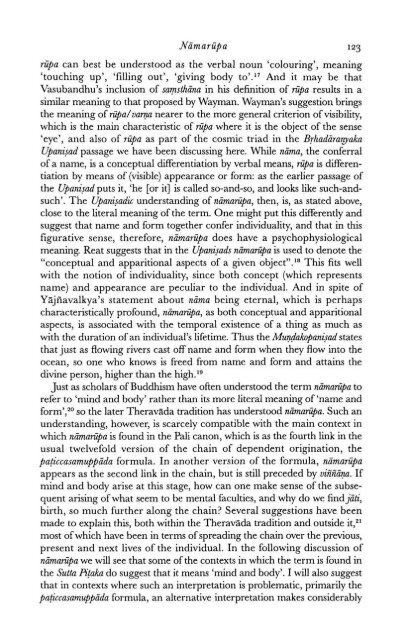Identity and Experience_Hamilton_1996
Identity and Experience_Hamilton_1996
Identity and Experience_Hamilton_1996
Create successful ePaper yourself
Turn your PDF publications into a flip-book with our unique Google optimized e-Paper software.
cpa can best be understood as the verbal noun 'colouring', meaning<br />
'touching up', 'filling out', 'giving body to'." And it may be that<br />
Vasub<strong>and</strong>hu's inclusion of samsthiina in his definition of riipa results in a<br />
similar meaning to that proposed by Wayrnan. Wayman's suggestion brings<br />
the meaning of riipa/varpz nearer to the more general criterion of visibility,<br />
which is the main characteristic of riipa where it is the object of the sense<br />
'eye', <strong>and</strong> also of riipa as part of the cosmic triad in the Brhadiirayaka<br />
Upani;ad passage we have been discussing here. While niima, the conferral<br />
of a name, is a conceptual differentiation by verbal means, riipa is differentiation<br />
by means of (visible) appearance or form: as the earlier passage of<br />
the Upani!ad puts it, 'he [or it] is called so-<strong>and</strong>-so, <strong>and</strong> looks like such-<strong>and</strong>such'.<br />
The Upani~adic underst<strong>and</strong>ing of niimariipa, then, is, as stated above,<br />
close to the literal meaning of the term. One might put this differently <strong>and</strong><br />
suggest that name <strong>and</strong> form together confer individuality, <strong>and</strong> that in this<br />
figurative sense, therefore, nimarfipa does have a psychophysiological<br />
meaning. Reat suggests that in the Upani;ads nimariipa is used to denote the<br />
"conceptual <strong>and</strong> apparitional aspects of a given object".18 This fits well<br />
with the notion of individuality, since both concept (which represents<br />
name) <strong>and</strong> appearance are peculiar to the individual. And in spite of<br />
Yajfiavalkya's statement about niima being eternal, which is perhaps<br />
characteristically profound, nimarzipa, as both conceptual <strong>and</strong> apparitional<br />
aspects, is associated with the temporal existence of a thing as much as<br />
with the duration of an individual's lifetime. Thus the Munp'akopani~ad states<br />
that just as flowing rivers cast off name <strong>and</strong> form when they flow into the<br />
ocean, so one who knows is freed from name <strong>and</strong> form <strong>and</strong> attains the<br />
divine person, higher than the high. lg<br />
Just as scholars of Buddhism have often understood the term niimariipa to<br />
refer to 'mind <strong>and</strong> body' rather than its more literal meaning of 'name <strong>and</strong><br />
form',20 so the later Theravada tradition has understood niimariipa. Such an<br />
underst<strong>and</strong>ing, however, is scarcely compatible with the main context in<br />
which niimariipa is found in the Pali canon, which is as the fourth link in the<br />
usual twelvefold version of the chain of dependent origination, the<br />
paticcasamuppiida formula. In another version of the formula, nimariipa<br />
appears as the second link in the chain, but is still preceded by uiiiiiiina. If<br />
mind <strong>and</strong> body arise at this stage, how can one make sense of the subsequent<br />
arising of what seem to be mental faculties, <strong>and</strong> why do we findjiti,<br />
birth, so much further along the chain? Several suggestions have been<br />
made to explain this, both within the Theravada tradition <strong>and</strong> outside it,21<br />
most of which have been in terms of spreading the chain over the previous,<br />
present <strong>and</strong> next lives of the individual. In the following discussion of<br />
nirnariipa we will see that some of the contexts in which the term is found in<br />
the Sutta fitaka do suggest that it means 'mind <strong>and</strong> body'. I will also suggest<br />
that in contexts where such an interpretation is problematic, primarily the<br />
pa~iccasamuppida formula, an alternative interpretation makes considerably


